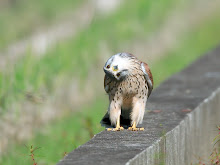Enhanced footage received
In late 2009 I was supplied with a restored version of the Doyle footage. I do not have details to hand of the work which was carried out on the footage, but can source these if requested.
This analysis uses the best quality version of the Doyle footage that I have seen to date.
Analysis
This analysis is a straightforward comparison between frames from the Doyle footage and David Fleay's footage of a thylacine circa 1933.
The following key diagnostic features, visible in the Doyle footage, are those that most pursuade me to argue that the animal in the Doyle footage is a thylacine, albeit on the mainland of Australia circa 1973:
- The proportion of the pes (hind foot) relative to other bones in the hind legs and relative to the rest of the body
- The proportion and posture of the tail relative to the rest of the body
- The shape of the hindquarters
- The depth of the neck and chest
The above features can be directly compared with known thylacine images and footage. Unfortunately there is no known footage of a running thylacine, so the "kangaroo-like" posture exhibited in multiple frames cannot be attributed to the thylacine with any certainty. The posture does, however, align with descriptions of the thylacine resembling a kangaroo or wallaby.
It should be noted that there are additional frames, not included in this analysis, which also show the key features being highlighted here.
Saturday, February 13, 2010
1973 Liz and Gary Doyle "Thylacine" footage analyzed.
If any of you are actively tracking the "extinct" Thylacine (or any so-declared extinct animal for that matter), you've probably seen this footage.
This was the footage taken by a couple named Liz and Gary Doyle in 1973 of a possible sighting. The film is short, blurry, and as always not reliable... but this is the best footage existing after its declared extinction.
Below is a link to an article I stumbled upon at wherelightmeetsdark.com (the best website out there for rare Australian animal sightings) of the official footage of the caged Thylacine and the Doyle footage being analyzed side-by-side.
Again, here's to hope and getting your hopes up!
Labels:
animals,
earth,
extinction,
footage,
gary doyle,
liz,
nature,
running,
tasmanian tiger,
thylacine

